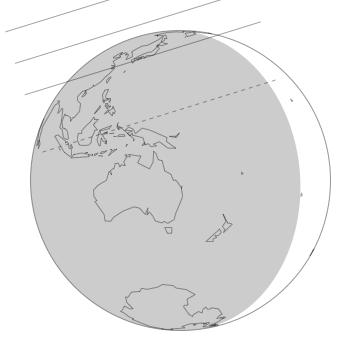



Prediction Last Updated: January 22, 2022
|
| 
|
|---|---|
No description available Across the globe pictured, the three solid black lines correspond to the northern limit, centerline, and southern limit of the Pluto's shadow. The Northern and Southern limits correspond to a radius of 1400 km. The dashed lines indicate 3-sigma errors. The shaded area on the globe represents where the sun is more than 0 degrees below the horizon. The shadow paths on the globe are an approximation at the geocentric close approach time; they disregard the Earth rotation during the event. | |
|
Table 1: Prediction Details |
|
| Pluto Geocentric Mid-time (hh:mm:ss) | June 22, 2022 15:46:57 ± 00:00:22. UT1 |
| Prediction | pred1.0_v1.0 |
| Pluto apparent magnitude | 14.3 |
| Occultation Star Gaia DR2 G magnitude | 16.678347 |
| Occultation Star Gaia DR2 rp magnitude | 16.03487 |
| Occultation Star Gaia DR2 bp magnitude | 17.143194 |
| Pluto Minimum Geocentric Separation | 0.2802 ± 0.0348 arcsec1 |
| Position Angle (Pluto relative to the star; measured north through east) | -17.18 |
1One standard deviation of random error
| |
Table 2: Reference Star Position |
|||
| Reference star position: (Gaia DR2) |
RA (h:m:s; J2000) | Dec (d:m:s; J2000) | Notes |
| Pluto.20220622 (Catalog; epoch of occ) | 20:00:45.5024 ± 0.001 | -22:40:11.2424 ± 0.0007 | |
| Pluto.20220622 (Measured) | - | - | |
Potential Star Duplicity: Unknown |
|||
Table 3: Projected KBO Offsets from Reference Ephemeris at the Time of the Event |
|||
| Body | RA (arcsec) | Dec (arcsec) | |
| Pluto | 0.03988 ± 0.0210 | 0.01783 ± 0.0270 | See Notes 5 and 6; Includes Pluto Center of Light to Center of Body correction |
2Measured position corresponds to RA offset of 0. and Dec. offset of 0.
3All "offsets" are degined in the ("corrected"–"reference") or ("observed"–"calculated") sense. The offsets should be added to reference positions to get the measured positions, which we use to calculate the prediction.
4The reference positions for Pluto are those given by JPL Horizon's ephemeris (Pluto source file: plu55l_merged
; Earth center source file: plu55l_merged)
5Data from various telescope were reduced with respect to the Gaia DR2 catalog. A model was developed to fit the residuals obtained from our measured positions compared to that of the object's JPL ephemeris. All residuals obtained from the different telescopes were consistent with the model. The model includes the first-order effects of errors in the orbital elements of the object: (i) constant offsets in RA and Dec, (ii) linear (in time) offsets in RA and Dec, and (iii) potential sinusoidal terms with companion's period. The model was propagated to obtain the predicted position and error of the KBO at the time of the occultation. The errors listed for the KBO are 1 standard deviation. | |||
Table 4: Site Information
|
|||||
Site |
East Longitude |
Latitude |
Site Altitude6 (km) |
Distance7 (km) |
Velocity (km/s) |
Beijing |
116 24 26 |
39 54 15 |
0. |
940 S |
21.50 |
Osaka |
135 30 08 |
34 41 37 |
0. |
1347 S |
21.55 |
Shanghai |
121 28 25 |
31 13 49 |
0. |
1387 S |
21.54 |
Taipei City |
121 33 55 |
25 01 58 |
0. |
1770 S |
21.57 |
Tokyo |
139 46 08 |
35 40 49 |
0. |
1367 S |
21.55 |
Geocentric |
.......... |
.......... |
-6378.14 |
6836 S |
21.19 |
6Altitude of each observatory is measured in kilometers above sea level.
| |||||
Table 5: Pluto
Occultation Predictions for Individual Sites |
|||||
Site |
KBO Immersion (UT)8 |
UT Mid-Time |
KBO Altitude |
Solar Altitude8 |
KBO Emersion (UT)8 |
Beijing |
15:47:06 |
15:47:54 |
19 |
15:48:43 |
|
Osaka |
15:46:37 |
15:46:55 |
30 |
15:47:12 |
|
Shanghai |
15:47:48 |
15:47:57 |
28 |
15:48:06 |
|
Taipei City |
........ |
15:48:11 |
34 |
........ |
|
Tokyo |
15:46:22 |
15:46:36 |
30 |
15:46:50 |
|
Geocentric |
........ |
15:46:57 |
........ |
||
8The errors on all times are ± 0:34. (34. seconds; one standard deviation). The solar altitude is given for locations where it is relevant (solar altitude greater than -18 deg). No entry in the immersion and emersion columns indicates that the occultation is not predicted to be visible at that site. | |||||
Webpage generated by C. A. Zuluaga (czuluaga@mit.edu) on January 22, 2022
Please direct all inquiries to PAL (planetary-astronomy@mit.edu)